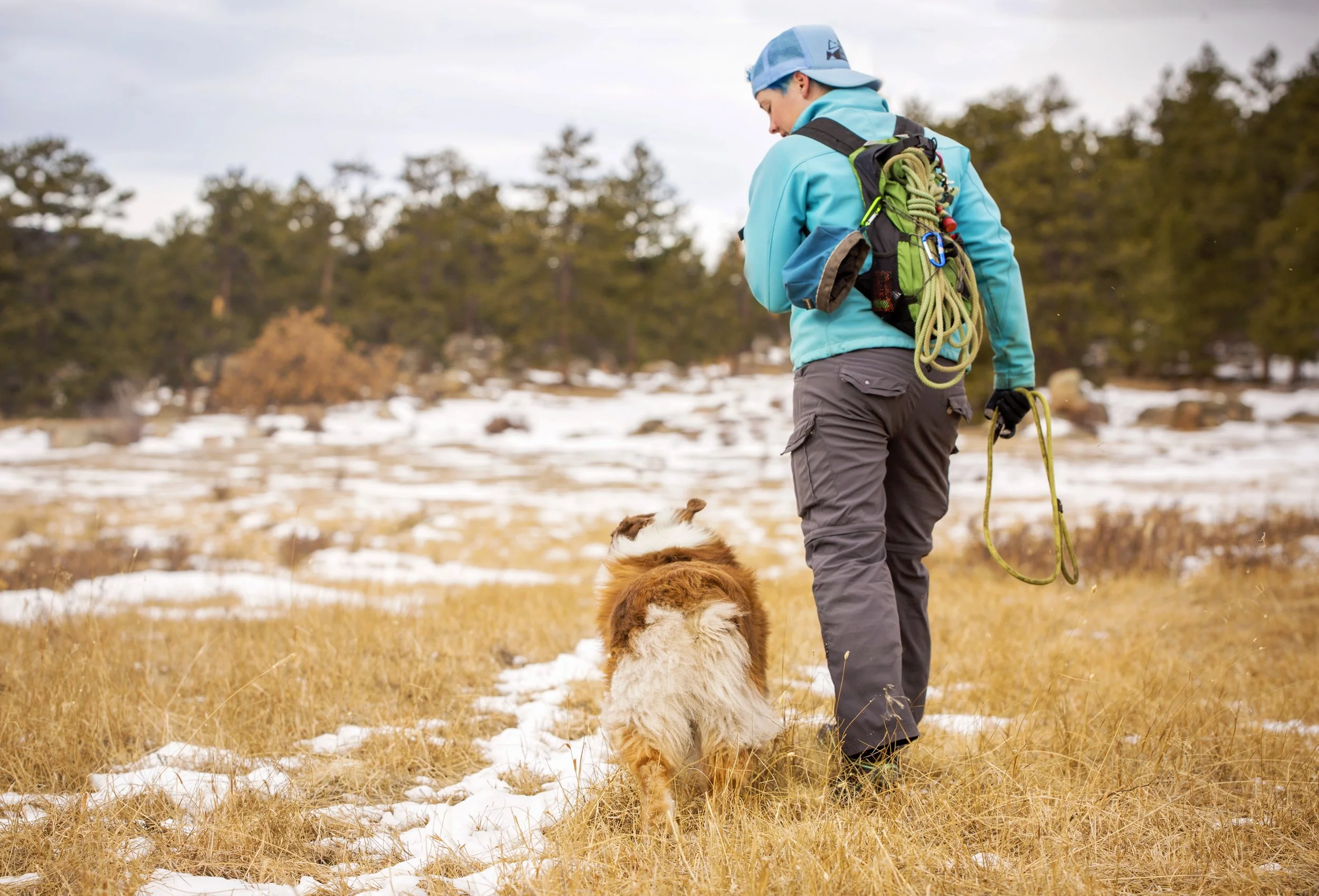Hello! My name is Laurel Gardner, and I am a second year veterinary student in the DVM Class of 2021, at Colorado State University. After working closely with Charissa to get help with training my own dog, Winnie, I have undeniably become fascinated with the effects of training methods on the human-animal bond and animal welfare. Charissa did an amazing job at helping Winnie and I to get the most out of our training and really work through the behavioral issues Winnie was having. After having experienced the benefits of positive reinforcement training with my own dog, I decided to do some research and look into the documented positive results that have been associated with this type of training, and it is clear there are a lot! Thank you for taking the time to read this piece, and feel free to send any questions concerning this paper to: Laurelmg@colostate.edu
The Effects of Training Method on Companion Dog Welfare
According to the American Veterinary Medical Association, “an animal is in a good state of welfare if (as indicated by scientific evidence) it is healthy, comfortable, well nourished, safe, able to express innate behavior, and if it is not suffering from unpleasant states such as pain, fear, and distress.” As animal welfare tends to be more commonly associated with animal basic needs such as the requirements of safe shelter, adequate nutrition, and a life void of the suffering and pain that is avoidable, it is common that mental and behavioral health may tend to be neglected, despite being an equally important portion of comprehensive animal welfare. After all, while the type of suffering we most frequently refer to is physical suffering, suffering can also undeniably be an aspect of psychological health that manifests in the behavior we see exhibited by “man’s best friend”.
Consider the timid puppy that hides beneath his owner’s chair and growls and snaps at any face that comes to greet him. Such a heightened state of fear, anxiety, and defensive aggression is a difficult mental state to live with, as human faces are an unavoidable life experience for that dog. Unfortunately, the case of the aforementioned puppy is not uncommon and has been strongly linked to the use of positive punishment (1) training techniques. According to a study of dog training methods published in the Journal of Veterinary Behavior in 2008, owners using some form of positive punishment were far more likely to have dogs with aggression against unfamiliar people or dogs (27%) compared to those owners who employed only positive reinforcement (10%). The owners using solely positive reinforcement in their training also had dogs with a much lower score for fear, avoidance, attention seeking, and general aggression [2]. Another study from 2004 showed that owners who used positive punishment had the highest proportion of dogs that showed “separation-related problems, either currently or in the past” [5]. While these owners may have good intentions in trying to train away bad behaviors in their dogs, it is clear that the effects of the training often make the situation worse than it was before. Yet another study in the journal, Applied Animal Behaviour Science, which directly observed owners while they trained their dogs, revealed that dogs trained with positive punishment were less likely to play with their owners when the owner offered a toy. This lack of desire to play could be the result of fear of humans associated with past punishments, and also indicates a lack of natural behavior, which is an essential part of good animal welfare [7]. Clearly, the use of positive punishment in dog training is not an effective way to promote good, complete animal welfare for our furry friends!
In addition to this mental distress, many forms of positive punishment involve physical reprimands including the use of shock collars, alpha rolls (2),and many other assault methods that can result in physical pain and suffering, affecting yet another aspect of comprehensive animal welfare for these dogs. For example, tools such as shock collars and choke collars have undeniably been linked to physical pain and suffering. These punishment tools can cause instability of the joints in the neck, induce inflammation of joints, cause paralysis of the nerves that allow normal breathing, and even cause glaucoma from the increased pressure placed on the veins of the neck [6]. According to Charissa Carvell, a double certified dog trainer that specializes in using only positive reinforcement methods, training “naked”, meaning without any collars or harnesses, is the best way to go. Eliminating this compulsive behavior to pull on the collar or leash (and other positive punishment tactics) makes the training process a more positive experience for both owner and dog, and often enhances the rate of learning, since the dog desires to please his human partner instead of fearing his owner and dreading training time [3].
Despite the unpleasant consequences associated with positive punishment on dog welfare, these training techniques have been popular for years among dog owners throughout the world. One sizeable reason for the popularity associated with this training method is that these tactics have been idealized in books and on television shows like Cesar Millan’s “The Dog Whisperer” that describe positive punishment as an efficient method to train a truly obedient dog [9]. But, are these methods truly that effective? Herron et al. disagree in their 2009 article published in Applied Animal Behaviour Science, noting that the idea of physically asserting oneself as the alpha to his or her dog in order to obtain obedience is a naïve misunderstanding of the root of canine behavioral issues, since current literature on dog behavior actually shows that most canine behavioral problems arise from anxiety, fear, and self-defense [4]. With this in mind, the supposedly effective strategies that accompany positive punishment training are in fact worsening the already present behavioral issues a dog may have. Dr. Karen Overall, a DVM and co-chair on the Scientific Working Group on Dogs (3), emphasizes how positive punishment training increases the “unreliability” of the dog, especially in real-world situations. Dr. Overall eloquently compares the use of positive punishment techniques in stressful situations to the phenomenon of escalating violence that occurs in human domestic violence situations. She explains how the use of aversive stimuli like “shocking” or hitting the dog only lead to increased arousal and negative emotions in the dog, which are likely to spill over as unwanted aggression toward the handler [6].
A 2010 study of owner relinquishment showed that 46% of dog relinquishments at shelters were due to some behavioral issue, aggression or otherwise [9]. With an increased tendency toward aggression, separation anxiety and an overall increase in “unwanted behaviors”, it is clear this training method can lead to frustrated owners who may give up and relinquish their dogs to nearby animal shelters, or worse, abandon them. In either case, the tendency toward relinquishment would similarly impact the dog’s welfare by creating more anxiety from living in a new, high-stress environment, or even restrict basic needs like nutrition and safe shelter if the dog is left to fend for itself. Also, with the overcrowding of our shelters and rescues being at an all-time high, relinquishment of dogs with correctable behavioral issues could result in euthanasia of healthy, treatable dogs that were simply the victims of inappropriate training methods.
All of these infractions on animal welfare are avoidable with the simple practice of positive reinforcement training in which verbal praise, play time, and other rewards for good behavior replace the punishments used to ward off bad behavior. Numerous studies have shown the effectiveness of positive reinforcement in training new tasks quickly and without frustration, preventing aggression toward familiar or unfamiliar faces, and strengthening the dog-owner relationship [2, 4, 5, 7]. Together, these aspects of positive reinforcement training help humans to improve their dog’s welfare in a comprehensive manner that allows for improved dog confidence and mental health, minimal physical harm in training, and reduced relinquishment rates.
Sources
1. “Animal Welfare: What Is It?” Avma.org, American Veterinary Medical Association, 2018, www.avma.org/KB/Resources/Reference/AnimalWelfare/Pages/what-is-animal-welfare.aspx.
2. Blackwell, Emily J., et al. “The Relationship between Training Methods and the Occurrence of Behavior Problems, as Reported by Owners, in a Population of Domestic Dogs.” Journal of Veterinary Behavior: Clinical Applications and Research, vol. 3, no. 5, Oct. 2008, pp. 207–217., doi:10.1016/j.jveb.2007.10.008.
3. Carvell, Charissa. 9 Oct. 2018.KPA-CTP, CPDT-KA, Head Trainer - Summit Dog Training LLC.
4. Herron, Meghan E., et al. “Survey of the Use and Outcome of Confrontational and Non-Confrontational Training Methods in Client-Owned Dogs Showing Undesired Behaviors.” Applied Animal Behaviour Science, vol. 117, no. 1-2, 24 Jan. 2009, pp. 47–54., doi:10.1016/j.applanim.2008.12.011.
5. Hiby, E F, et al. “Dog Training Methods: Their Use, Effectiveness, and Interaction with Behavior and Welfare.” Animal Welfare, vol. 13, 2004, pp. 63–69., doi:10.1107/s0108768107031758/bs5044sup1.cif.
6. Overall, Karen L. “Considerations for Shock and ‘Training’ Collars: Concerns from and for the Working Dog Community.” Journal of Veterinary Behavior, vol. 2, no. 4, 2007, pp. 103–107., doi:10.1016/j.jveb.2007.07.001.
7. Rooney, Nicola Jane, and Sarah Cowan. “Training Methods and Owner–Dog Interactions: Links with Dog Behaviour and Learning Ability.” Applied Animal Behaviour Science, vol. 132, no. 3-4, 21 Apr. 2011, pp. 169–177., doi:10.1016/j.applanim.2011.03.007.
8. Salman, M.d., et al. “Human and Animal Factors Related to Relinquishment of Dogs and Cats in 12 Selected Animal Shelters in the United States.” Journal of Applied Animal Welfare Science, vol. 1, no. 3, 4 June 2010, pp. 207–226., doi:10.1207/s15327604jaws0103_2.
9. Sumner, Kay, and Sheila Emery. The Dog Whisperer with Cesar Millan, National Geographic Channel, 13 Sept. 2004.
Notes
(1) Positive punishment is any training in which a target behavior is decreased following presentation of an aversive stimulus.
(2) Alpha roll is a direct aversive punishment in which the owner dominantly “rolls” the dog to its back and holds it down.
(3) Scientific Working Group on Dogs is a board of behavioral and veterinary experts gathered by the FBI to discern the best practices in dog training for working canines in the field.





































